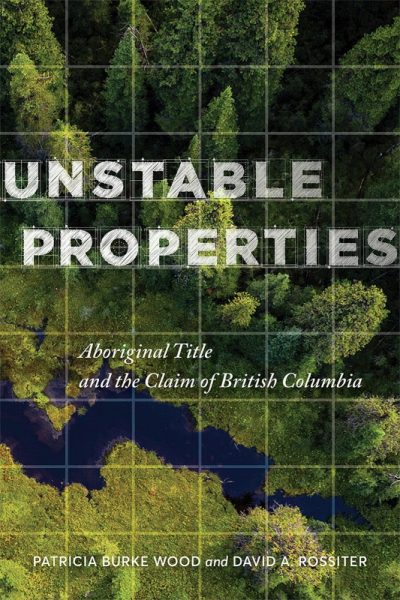
Unstable Properties: Aboriginal Title and the Claim of British Columbia
Review By Bruce McIvor
May 24, 2023
BC Studies no. 217 Spring 2023 | p. 116-117
We all have a lot to learn from historical-geographers. By combining disciplines, they connect the dots between historical forces and the making (and unmaking) of places many assume are constant and immutable. Consequently, Patricia Burke Wood’s and David A. Rossiter’s Unstable Properties: Aboriginal Title and the Claim of British Columbia is a welcome addition to a literature that has been dominated by lawyers, historians, journalists, and political scientists.
In Unstable Properties, Wood and Rossiter set out to interrogate the Crown’s claims to the lands of the Indigenous Peoples of present-day BC. They seek to explain how colonizers developed and relied on a story of “settler rebirth” to erase Indigenous people from their lands and how, ultimately, the settler narrative was upended by steadfast Indigenous resistance. They argue that rather than succeeding in marginalizing and silencing Indigenous Peoples, the unresolved “land question” has brought Indigenous people to the centre of political power and forced British Columbians to contend with an incomplete, unstable property regime.
The theoretical underpinnings of Unstable Properties can be traced to Henri Lefebvre’s writings on the “production of space,” ideas which have inspired many, including my own work on energy regimes and hydroelectric power. Lefebvre’s central argument was that space is contested, multilayered and continually created, destroyed and recreated through the exercise of power that simultaneously seeks to oppress and liberate. Lefebvre’s ideas are present, explicitly or implicitly, in the work of many of the most influential historians and geographers of the last fifty years including David Harvey, Edward Soja, William Cronon, and countless others. One of the strengths of Unstable Properties, is that it successfully bridges the gap between Lefebvre’s intellectual tradition and the work of Indigenous legal scholars who have crafted powerful critiques of Canadian Aboriginal law, including Taiaiake Alfred, John Borrows, Gordon Christie, and Val Napoleon.
While the early chapters of Unstable Properties are a helpful summary of the historical and legal milestones that resulted in the current state of legal uncertainty around the Crown’s claim to land in BC, those familiar with the work of Jean Barman, Robin Fisher, Hamar Foster, Cole Harris, and Paul Tennant will find little that’s new or innovative. It is when the authors step back in Chapter 5 to take a wider view of BC as an unstable abstraction based on “a discourse of worthiness and deservedness” (186) that they embark on a distinct and potentially fruitful analysis. Unfortunately, the promise of Chapter 5 culminates in an underwhelming conclusion: modern-day BC is the consequence of settler-colonial governments having become entangled with the preexisting people and landscapes. The path out of this entanglement is predicated on acknowledging the inherent instability of sovereignty and territoriality and living up to collective constitutional principles.
Legal analysis should never be the sole purview of lawyers and many non-lawyers have contributed mightily to our understanding of how Canadian law works to circumscribe and oppress Indigenous people–Michael Asch’s work exemplifies the best of these contributions. Nonetheless, Aboriginal law’s complexities pose a challenge for non-lawyers. The authors heap criticism on the Supreme Court for not requiring governments to consult with First Nations when contemplating legislation (Mikisew Cree, 2018) but fail to mention that the Court held that a failure to consult leaves governments vulnerable to a legal challenge by First Nations that said legislation infringes their constitutionally protected rights. They also criticize the Court for failing in the Williams Lake decision to “address the larger question of sovereignty underlying a specific land claim…” (217). Specific claims by their nature preclude any discussion of sovereignty. Their criticism is equivalent to criticizing a cow for not being a butter knife.
There is much in Unstable Properties to commend itself to a wide audience, but any reader looking for an accurate understanding of the case law would be well advised to have a copy of Jim Reynold’s Aboriginal Peoples and the Law close at hand.
Publication Information
Wood, Patricia and David Rossiter. Unstable Properties: Aboriginal Title and the Claim of British Columbia. Vancouver: University of British Columbia Press, 2023. 256 pp. $37.95 paper.
